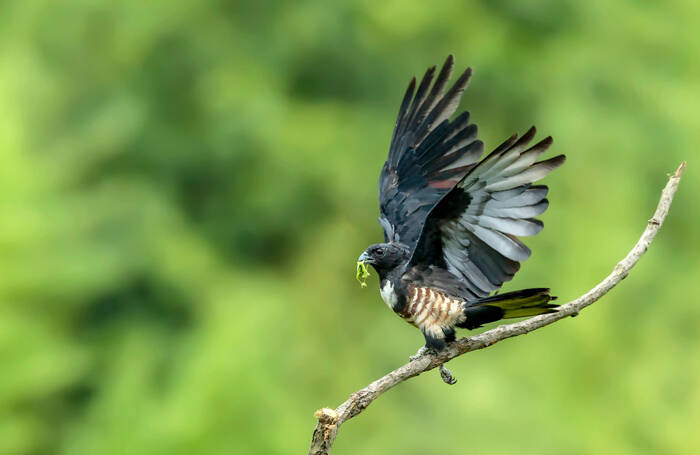Aviceda leuphotes
IUCN
LCBasic Information
Scientific classification
- name:Aviceda leuphotes
- Scientific Name:Black Baza,Aviceda leuphotes
- Outline:Raptor
- Family:Accipitridae Beehawks Falconiformes
Vital signs
- length:30-33cm
- Weight:178-217g
- lifetime:Aviceda leuphotes
Feature
The top of the head has a long, vertical blue-black crest
Distribution and Habitat
Distributed in Bangladesh, Bhutan, Cambodia, China, India, Indonesia, Lao People's Democratic Republic, Malaysia, Myanmar, Nepal, Singapore, Sri Lanka, Thailand, Vietnam.
Distributed in China, distributed in Sichuan, Zhejiang, Fujian, Jiangxi, Hunan, Guangdong, Guangxi, Guizhou, Yunnan, Hainan and other places. There are 5 subspecies in the world, 3 subspecies in China, the Sichuan subspecies distributed in Sichuan, the nominal subspecies distributed in Hainan and Yunnan estuaries, and the southern subspecies distributed in other areas.
The regionality of the black-crowned cuckoo falcon is not uncommon. It is a resident bird in Sichuan and Yunnan, China, and a summer migratory bird in other areas. It inhabits plains, low mountains and hills, and alpine forests. It also appears in sparse forests, grass slopes, villages and fields at the edge of forests.
Appearance
The head of the head has long and vertically erect blue-black crown feathers, which is extremely conspicuous. The iris is purple-brown or blood-reddish brown. The beak and legs are lead-colored. The coverts and tail feathers on the head, neck, back and tail are all dark brown with a blue metallic sheen, which is different from that of the Brown-crested Falcon. The wings and shoulders have white spots, the throat and neck are black, the upper chest has a broad star-shaped white spot, the lower chest and abdomen have wide white and chestnut horizontal spots, the center of the abdomen, the coverts on the legs and The feathers under the tail are all black, the inner side of the tail feathers is white, and the outer side has chestnut patches. When flying, the wings are broad and round, and the black underwing feathers and tail feathers are in sharp contrast to the silver-gray flight feathers and tail feathers; when viewed from above, the whole body is black, with a wide, extremely conspicuo
Details
The Black-crowned Bazaar is a small to medium-sized bird of prey with four subspecies.

The Black-crowned Bazaar often moves alone, sometimes in small groups of 3-5 or so. It often soars and hovers over the forest, occasionally flapping its wings and flying. It is very leisurely, and sometimes it moves and hunts in the forest and on the ground. It is alert and timid, but sometimes it seems dull and lazy. The crest on its head often stands high and falls low, as if it is very sensitive to what is happening around it. It is active mainly during the day, especially in the early morning and dusk. It mainly feeds on insects such as locusts, grasshoppers, cicadas, and ants. It also likes to eat bats, as well as small vertebrates such as mice, lizards and frogs. Because there are two sharp teeth on the peak of its mouth, it looks very sharp. The call is a falsetto scream of one to three light syllables, like the meowing of a seagull.
The breeding season of the black-crowned cuckoo falcon is from April to July. Nests are located in forests on river banks or in tall trees nearby. The nests are mainly made of dead branches, with grass stems, grass leaves and bark fibers inside. Each nest contains 2-3 eggs, which are obtusely oval, off-white with tea yellow, and measure 35-46 mm × 29-38 mm, with an average of 39 mm × 32 mm.
Due to continued habitat destruction by deforestation, the number of black-crowned cuckoo falcons is considered to be declining. Between 2016 and 2020, forest cover within the species' range decreased by 5.3% (Global Forest Watch 2021), equivalent to 16.7% of the next three-generation forecast. The species uses orchards, gardens and agricultural areas in winter, but mainly nests in forests. There are no other known major threats to the species, so it is believed to be declining at a similar rate to forest loss.
In March 2022, the Black-crowned Cuckoo Falcon, a national second-level key protected wild animal, was accidentally discovered in Leigongshan National Nature Reserve. The appearance of the Black-crowned Cuckoo Falcon has updated the number of national key protected wild animals in Leigongshan National Nature Reserve to 61. Listed in the "Red List of Endangered Species of the World Conservation Union" (IUCN) 2021 ver3.1-Least Concern (LC).
Listed in Appendix I, Appendix II and Appendix III of the 2019 edition of the Convention on International Trade in Endangered Species of Wild Fauna and Flora (CITES).
Listed in the second level of China's "National Key Protected Wildlife List" (February 5, 2021).
Protect wild animals and stop eating game.
Maintaining ecological balance is everyone's responsibility!








